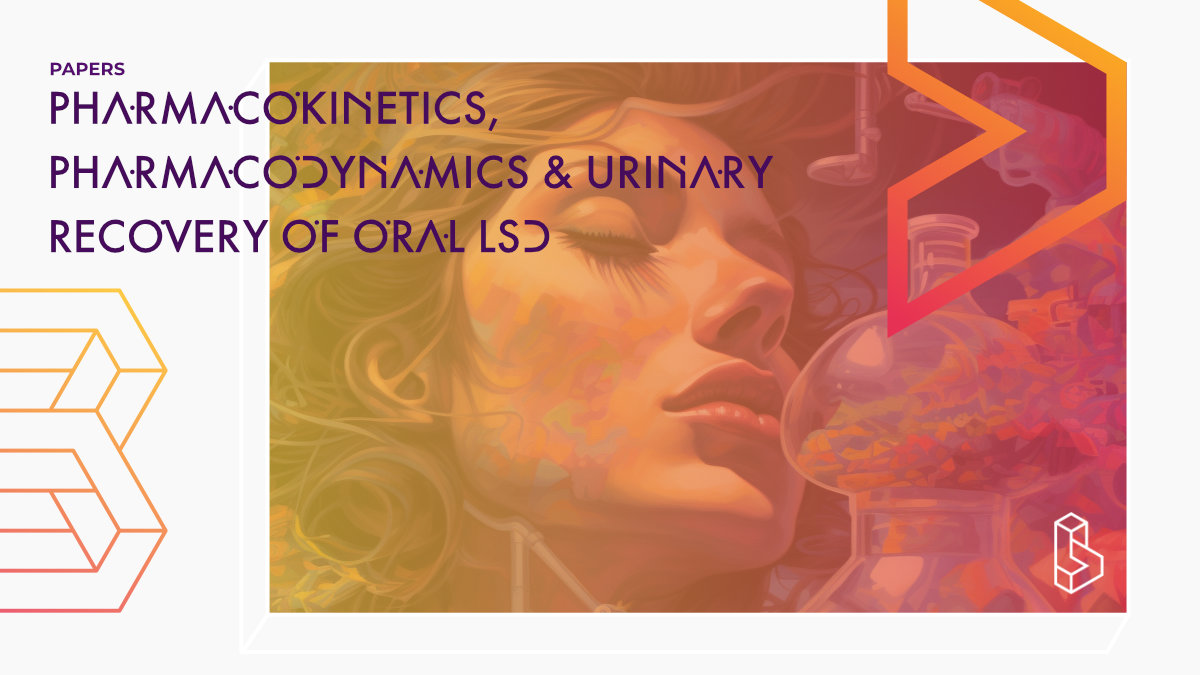This pharmacokinetic study (n=28) investigated the effects of oral LSD doses of 85 and 170 μg on healthy participants over 24 hours. The results showed mean maximal LSD concentrations of 1.8 ng/ml and 3.4 ng/ml for the respective doses, reaching peak concentrations after approximately 1.7 hours. Elimination half-lives were between 3.7 and 4.0 hours. Only 1% of LSD was found unchanged in urine within 24 hours, while 16% was eliminated as 2-oxo-3-hydroxy-LSD. Subjective effects lasted between 9.3 and 11 hours, with intensity peaking at 77% and 87% for the two doses.
Abstract of Pharmacokinetics, pharmacodynamics & urinary recovery of oral LSD
“Aim Lysergic acid diethylamide (LSD) is currently investigated for several neurological and psychiatric illnesses. Various studies have investigated the pharmacokinetics and the pharmacokinetic-pharmacodynamic relationship of LSD in healthy participants, but data on urinary recovery and confirmatory studies are missing.
Method The present study characterized the pharmacokinetics, pharmacokinetic-pharmacodynamic relationship, and urinary recovery of LSD at doses of 85 and 170 μg administered orally in 28 healthy participants. The plasma concentrations and subjective effects of LSD were continuously evaluated over a period of 24 hours. Urine was collected during three time-intervals (0-8, 8-16, and 16-24h after LSD administration). Pharmacokinetic parameters were determined using compartmental modeling. Concentration-subjective effect relationships were described using pharmacokinetic-pharmacodynamic modeling.
Results Mean (95% confidence interval) maximal LSD concentrations were 1.8 ng/ml (1.6-2.0) and 3.4 ng/ml (3.0-3.8) after the administration of 85 and 170 μg LSD, respectively. Maximal concentrations were achieved on average after 1.7 h. Elimination half-lives were 3.7h (3.4-4.1) and 4.0h (3.6-4.4), for 85 and 170 μg LSD, respectively. Only 1% of the administered dose was recovered from urine unchanged within the first 24 hours, 16% was eliminated as 2-oxo-3-hydroxy-LSD (O-H-LSD). Urinary recovery was dose-proportional. Mean (±SD) durations of subjective effects were 9.3±3.2 h and 11±3.7 h, and maximal effects (“any drug” effects) were 77%±18% and 87%±13% after 85 and 170 μg of LSD, respectively.
Conclusion The present novel study validates previous findings. LSD exhibited dose-proportional pharmacokinetics and first-order elimination kinetics and dose-dependent duration and intensity of subjective effects. LSD is extensively metabolized and shows dose-proportional urinary recovery.
Authors: Friederike Holze, Livio Erne, Urs Duthaler & Matthias E. Liechti
Find this paper
https://doi.org/10.1111/bcp.15887
Open Access | Google Scholar | Backup | 🕊
Cite this paper (APA)
Holze, F., Erne, L., Duthaler, U., & Liechti, M. E. (2023). Pharmacokinetics, pharmacodynamics and urinary recovery of oral lysergic acid diethylamide (LSD) administration in healthy participants. British Journal of Clinical Pharmacology.
Study details
Compounds studied
LSD
Topics studied
Healthy Subjects
Study characteristics
Original
Placebo-Controlled
Double-Blind
Within-Subject
Randomized
Participants
28
Humans
Authors
Authors associated with this publication with profiles on Blossom
Matthias LiechtiMatthias Emanuel Liechti is the research group leader at the Liechti Lab at the University of Basel.
Institutes
Institutes associated with this publication
University of BaselThe University of Basel Department of Biomedicine hosts the Liechti Lab research group, headed by Matthias Liechti.
Compound Details
The psychedelics given at which dose and how many times
LSD 85 - 170μg | 2x
Linked Research Papers
Notable research papers that build on or are influenced by this paper
Pharmacokinetics and concentration-effect relationship of oral LSD in humansThis double-blind, placebo-controlled, within-subjects study (n=16) evaluated the pharmacokinetic profile of oral LSD (200 μg) in humans. The analysis found that the acute subjective and sympathomimetic effects of LSD lasted for up to 12 hours and were closely linked to the plasma concentrations over time and showed no acute tolerance. This is the first such study and can act as a potential reference for the assessment of intoxication with LSD.
Linked Clinical Trial
Direct Comparison of Altered States of Consciousness Induced by LSD and PsilocybinThe investigators will compare the acute effects of LSD, psilocybin and placebo.

